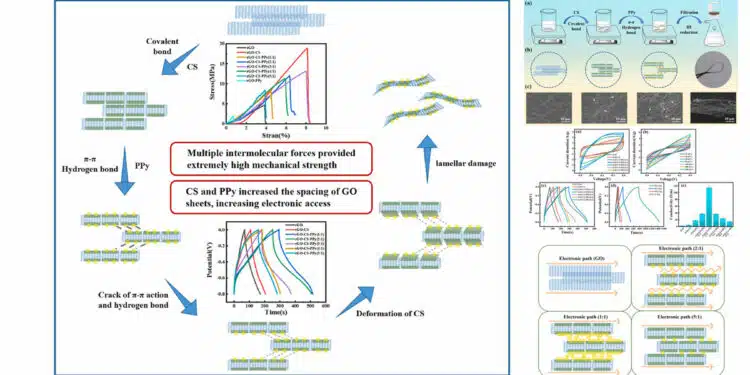Researchers from China published a study in Carbon Journal of enhancing the mechanical and electrochemical properties of flexible supercapacitors using reduced graphene oxide composite films through the combined actions of chitosan and polypyrrole.
Researchers from Institute of Polymer Materials, School of Material Science and Engineering, Qingdao University, China published results of their work to improve properties of flexible supercapacitors.
Abstract
With high conductivity, large surface area and a large number of interlayer structures, graphene has become an excellent choice for electrode materials in supercapacitors, but its mechanical strength and electrochemical performance need to be further improved.
Herein, chitosan and polypyrrole were introduced into graphene oxide successively by a simple and low-cost method, and then the composite film was reduced by hydroiodic acid, leading to excellent mechanical and electrochemical properties.
Structural characterizations verified the existence of covalent bond, π-π interaction and hydrogen bond, effectively improving the poor interface bonding between graphene sheets. The tensile strength and the microhardness of the composite film was increased by 182 % and 3000 % compared with original film. Electrochemical tests showed significantly improvement of the electrochemical activity, and the capacitance value could reach 170 F/g.
This composite film with high strength and high electrochemical performance will become a promising candidate material in the field of flexible supercapacitors.
Results Summary and Conclusion
CS and PPy were grafted onto the surface of GO through various intermolecular forces such as covalent bond, π-π interaction, and hydrogen bond, which effectively expanded the layer spacing between GO sheets, improving the mechanical strength and electrochemical strength of the composite film.
Specifically, the tensile strength of the film increased from 4.68 MPa to 13.20 MPa, and the microhardness increased from 207 HV to 6418 HV, which was attributed to the consumption of load by intermolecular forces. The capacitance value increased from 64 F/g to 170 F/g due to the effect of PPy on the increase of the active area of GO.
This work will provide an economical and feasible way for supercapacitors with high mechanical and electrochemical properties. Despite the positive outcomes, there are still some limiting factors and challenges. In practical applications, the performance of supercapacitors may degrade over time.
Therefore, it is necessary to conduct in-depth research on the long-term stability and durability of the composite material, including its storage and cycling stability under different environmental conditions, to further enhance the performance of the composite material and promote its application in supercapacitors and other related fields.
Read the original full article: https://doi.org/10.1016/j.carbon.2024.119715































